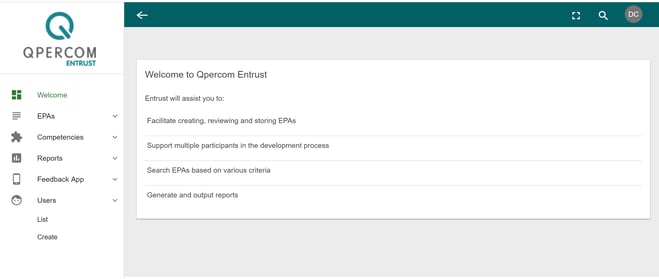Competency-Based Medical Education (CBME) is changing the delivery and assessment of medical education in healthcare institutions around the world. CBME is outcome-based education, focusing on what is attained in terms of knowledge, skill, behaviour and attitude. This brings a wider focus to education, not just what is learned from the actual teaching process.
Entrustable Professional Activities (EPAs) are an effective measuring tool for these competencies. An EPA is a core unit of professional practice which can be entrusted to a trainee as soon as they have demonstrated the competence to conduct the task without supervision. Qpercom developed an EPA Management System, Entrust, to provide a digital solution for storing and managing EPAs. An accompanying work-based assessment app measures the trainee feedback, to complete the feedback loop between trainer and trainee.
But what are the benefits of storing and accessing these EPAs digitally over paper?

1. Access from anywhere
Creating and storing an EPA digitally offers curriculum developers and administrators the opportunity to save time. Once an EPA and associated competencies and activities are saved on Entrust, they can be accessed from any device from any location, be that at work or remotely.
2. Collaboration
You can choose which members of your curriculum development team can access each EPA and work together to develop the content within your EPAs. Entrust has different user roles to accommodate this process so you can assign people as Administrators to manage the system, as Editors to make changes to an EPA and as a Contributor to view EPA content without access to edit.
3. Continuous refinement
EPAs can be updated and adjusted at any time to reflect changes in health science education. Entrust allows you to make changes to EPAs, Competencies, Activities, Proficiency Levels and Minimum Volume of Practice. As soon as changes are published, the updated content will appear within the accompanying work-based assessment app for trainers and trainees to use within their Feedback Reports.
4. Save time with reusable content
You can reuse all of the information stored within EPAs on Entrust as you further develop your curriculum. EPAs can be cloned and used as a template for another EPA, so you don't need to develop an EPA from scratch. All competencies stored on Entrust can be added to multiple EPAs. Proficiency levels associated with each competency can be set for each developmental milestone specific to each EPA it is attached to.
5. Tagging of EPAs and individual competencies against educational framework
All EPAs can be tagged against specific roles within your educational framework. This is useful for presenting your curriculum from the point of view of each role, and the EPAs associated with each role.
6. Mapping of teaching and learning events for each competency
When you add a competency to Entrust you can tag that competency against where it is taught and learned within your curriculum. This enables you to get a quick view of all where all competencies are currently being taught. It can also assist you in identifying gaps and overlaps within your curriculum.
7. Blueprinting of the modes of assessment used for each competency
Similar to mapping, you can tag your competencies against your different modes of assessment to pinpoint exactly where competencies should be assessed. Tagging these modes give you instant insight into where your learners are being adequately assessed or under assessed on each competency.
To see Entrust in action, click here Qpercom Entrust Management System.
For more information on Entrust email info@qpercom.com
Click here to request a demo.


